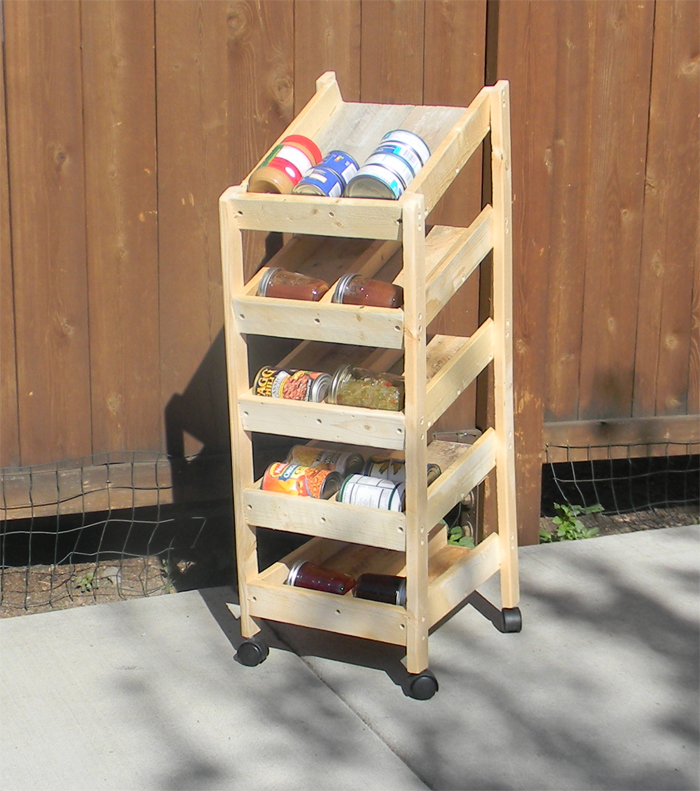
I am a couponer, one of those crazy ladies that needs more space than she ever has. And, as such, I needed an organized and easy way to store canned goods while making sure nothing was expiring or going to waste. They sell fancy contraptions that do such a thing, but in the nature of trying to save a few bucks, I knew I had to make one myself.
*** As you go, check for square and make sure legs are all even. Stand back and make adjustments as necessary as you go.***
This is a fairly easy plan even with all of the crazy measurements, I found it best to measure and measure again.
Because this requires angle cuts and can be tricky to hold in place while drilling, I would not consider this a beginner plan. However, Ana's audience always surprises me, so if you're up for a challenge... go for it!
You can see my blog post here: http://www.creativebaggage.com/standing-rotating-can-rack/#more-286
I would love to see any photos of racks you've made and ways you made it your own!
Preparation
4-1×2 @8 feet (approx. $1 each)
3-1×6 @8 feet (approx. $6 each) You will have extra left over, and could get away with 2, but I would recommend 3 for any “oops” OR if you can find pallets with 1x6s, use those to conserve and re-use. Plus no one will see these once the rack is stocked.
1 1/4″ or 1 1/2″ screws
Countersinking bit, or drill bit
Wood Glue
Tape Measure
Cuts:
10- 1×2 @10 1/2″ (shelf supports) 2 per tier
5- 1×2 @11 3/4″ (front aprons)
2- 1×2 @ 29 1/2″ cut at an angle to 28 1/2″ on one end, with 29 1/2″ being the longest point (front legs)
2- 1×2 @36″ cut at an angle to 35″ on one end, with 36″ being the longest point (back legs)
Cut the shelves for each tier as follows:
Tier 1-
3- 1×2 @14″ (side aprons and center divider)
2- 1×6 @14″ (shelves)
Tier 2-
3- 1×2 @14 1/4″ (side aprons and divider)
2- 1×6 @14 1/4″ (shelves)
Tier 3-
3- 1×2 @14 1/2″ (side aprons and divider)
2- 1×6 @14 1/2″ (shelves)
Tier 3-
3- 1×2 @15″ (side aprons and dividers)
2- 1×6 @15″ (shelves)
Tier 4-
3- 1×2 @15 1/4″ (side aprons and dividers)
2- 1×6 @15 1/4″ (shelves)
Tier 5-
3- 1×2 @15 1/2″ (side aprons and dividers)
2- 1×6 @15 1/2″ (shelves)
Start with shelves first and cut legs, aprons and dividers second. This will help make up for differences as you go.
Please read through the entire plan and all comments before beginning this project. It is also advisable to review the Getting Started Section. Take all necessary precautions to build safely and smartly. Work on a clean level surface, free of imperfections or debris. Always use straight boards. Check for square after each step. Always predrill holes before attaching with screws. Use glue with finish nails for a stronger hold. Wipe excess glue off bare wood for stained projects, as dried glue will not take stain. Be safe, have fun, and ask for help if you need it. Good luck!
Instructions
Step 1
Start by building each shelf with the bottom supports, shelve pieces and dividers. Pre-drill and countersink (optional) each piece as you go! Pre-drilling will keep the wood from splitting, and save you tons of time in the long-run!
Step 2
Put side aprons on each shelf
Step 3
Put front apron on each shelf, and mark shelves with number for placement on rack
Step 4
Apply legs one at a time, starting with bottom shelf. This can be tricky, and having a helper will be ideal. However, I did it solo, and it worked fine
The bottom shelf begins 1″ up from the front legs, and 2 1/2″ up from the bottom of the back legs, giving you a 1 1/2″ drop for cans to roll
Step 5
Add each subsequent shelf up 4″ from top of previous shelf front, and 5 1/2″ up front top of bottom shelf back.
It is always recommended to apply a test coat on a hidden area or scrap piece to ensure color evenness and adhesion. Use primer or wood conditioner as needed.











Comments
Sue_McL
Thu, 12/22/2011 - 09:08
Love it!
I've seen other plans but nothing as sturdy.
Only thing I will change is to customize it to the space I have in my laundry room and maybe make it a little taller.
Thanks for these plans
CreativeBaggage
Thu, 12/22/2011 - 12:01
Thanks!
When I set out to make this, all I could find plans for was ones made out of cardboard.. I am by no means great with tape and glue, and I couldn't figure out how it would last. This one is stored in our hall closet with the vacuum, so it is a bit small. I have plans on making another one that wil hold 100+ cans. Maybe when we get past Christmas and the New Year. I would love to see what you come up with!
SabySmooth1
Thu, 12/22/2011 - 13:49
I'm in love!
Okay, as a fellow crazy couponer, I am SO happy to see this! You rock! This is going straight into my things to make list!